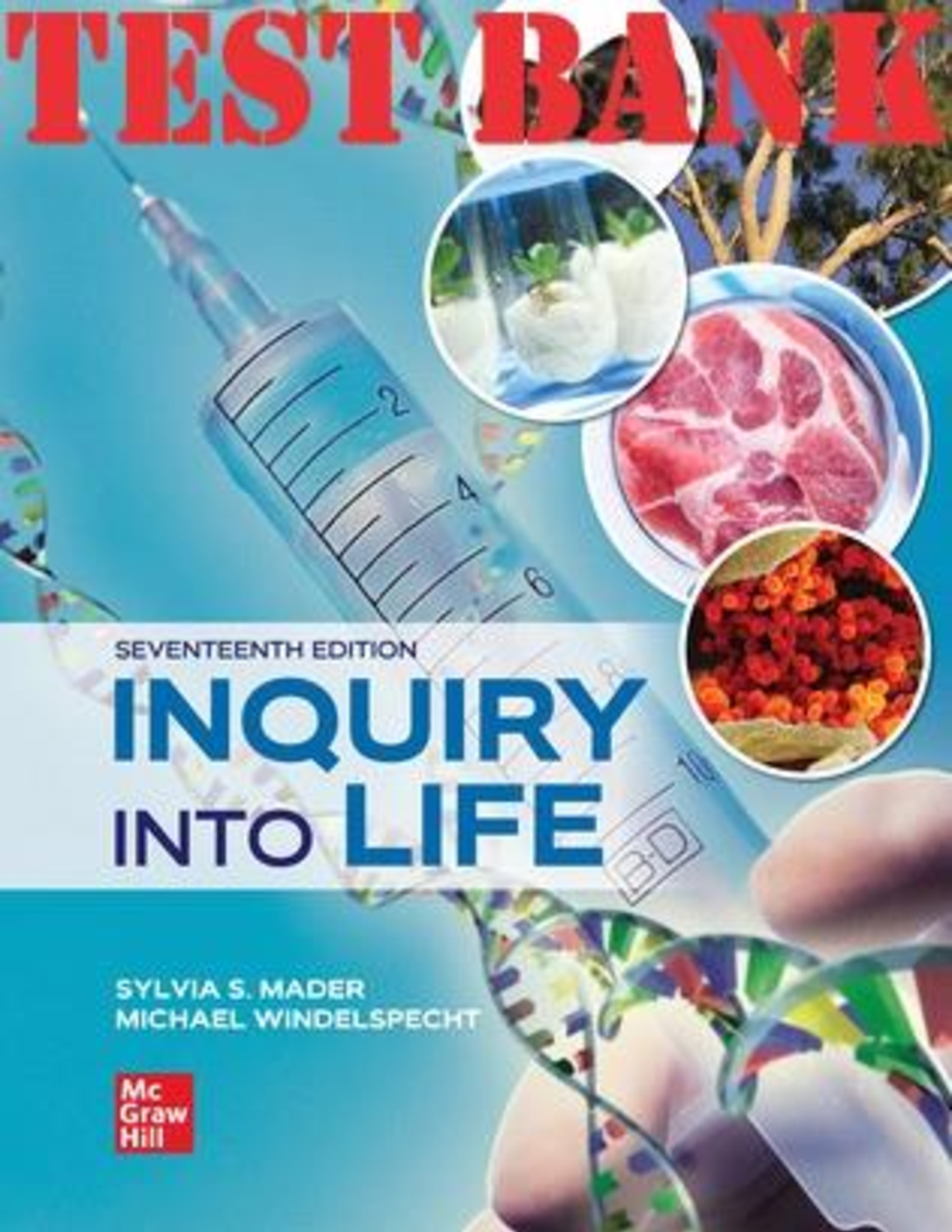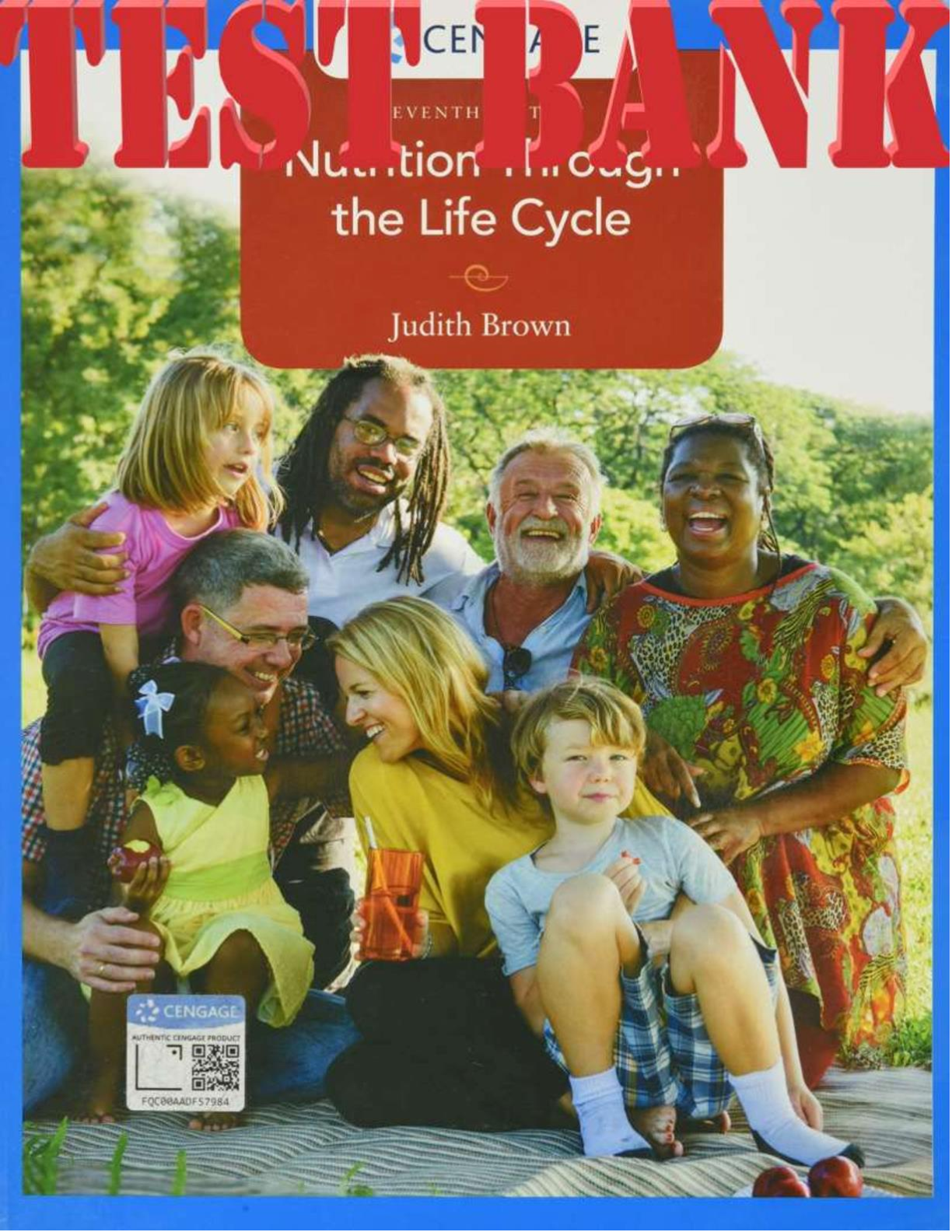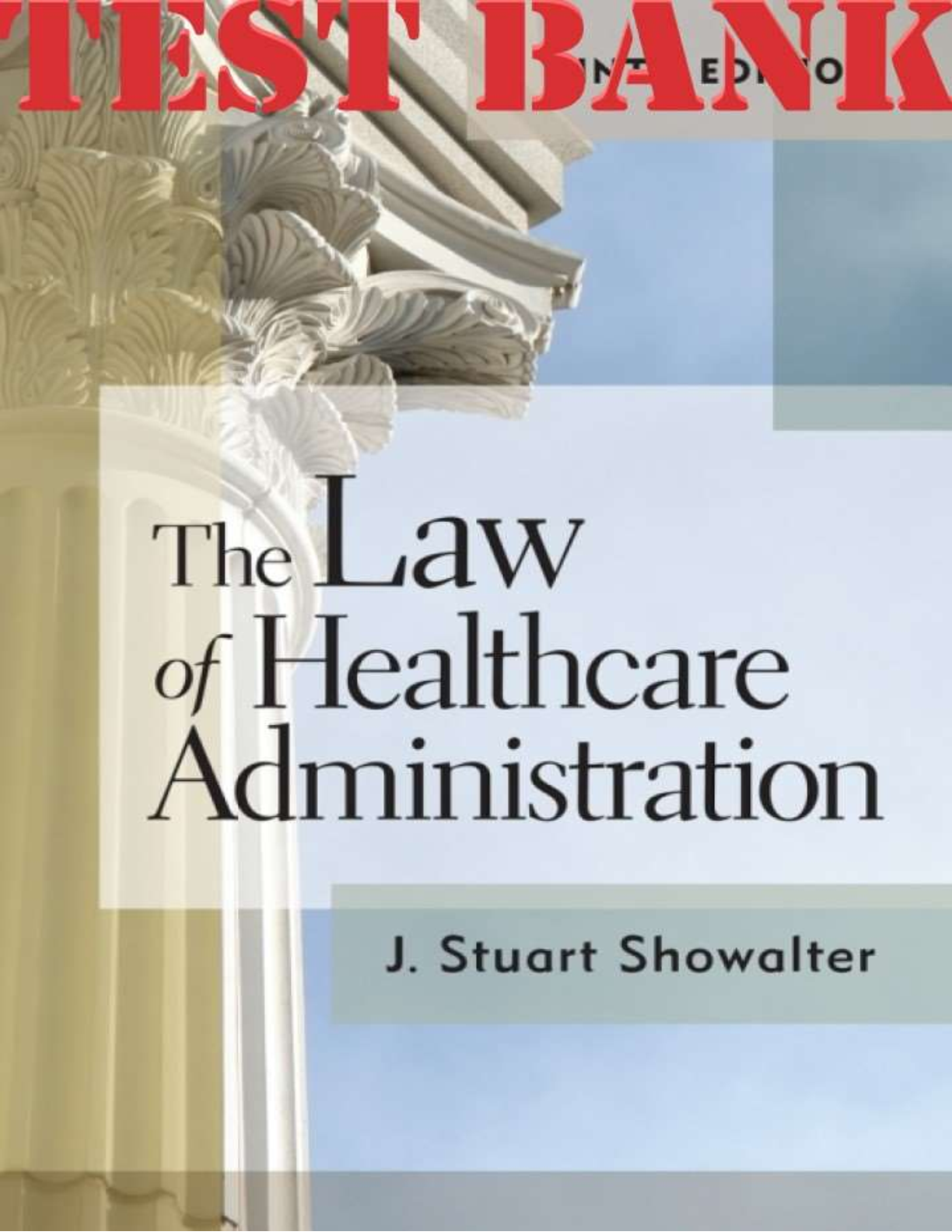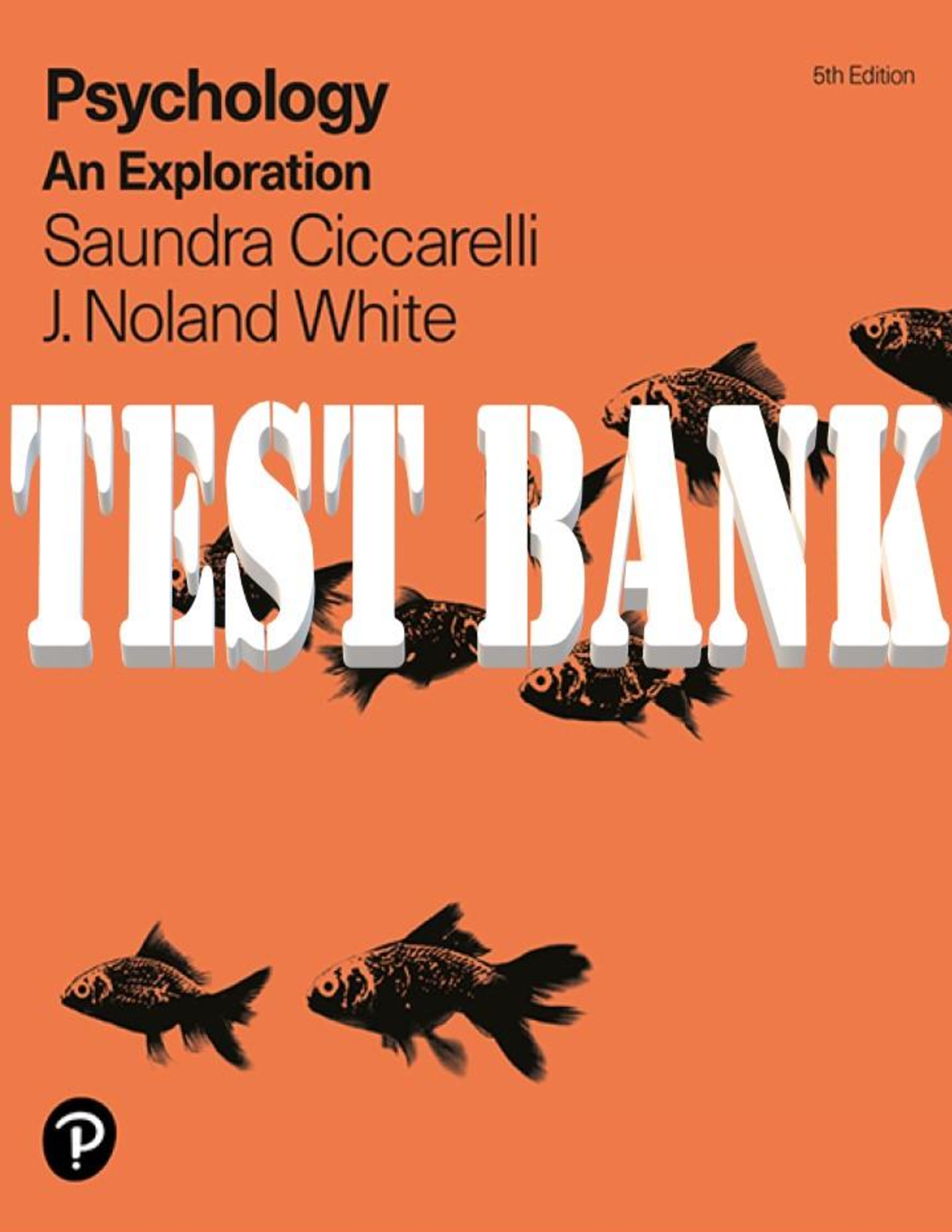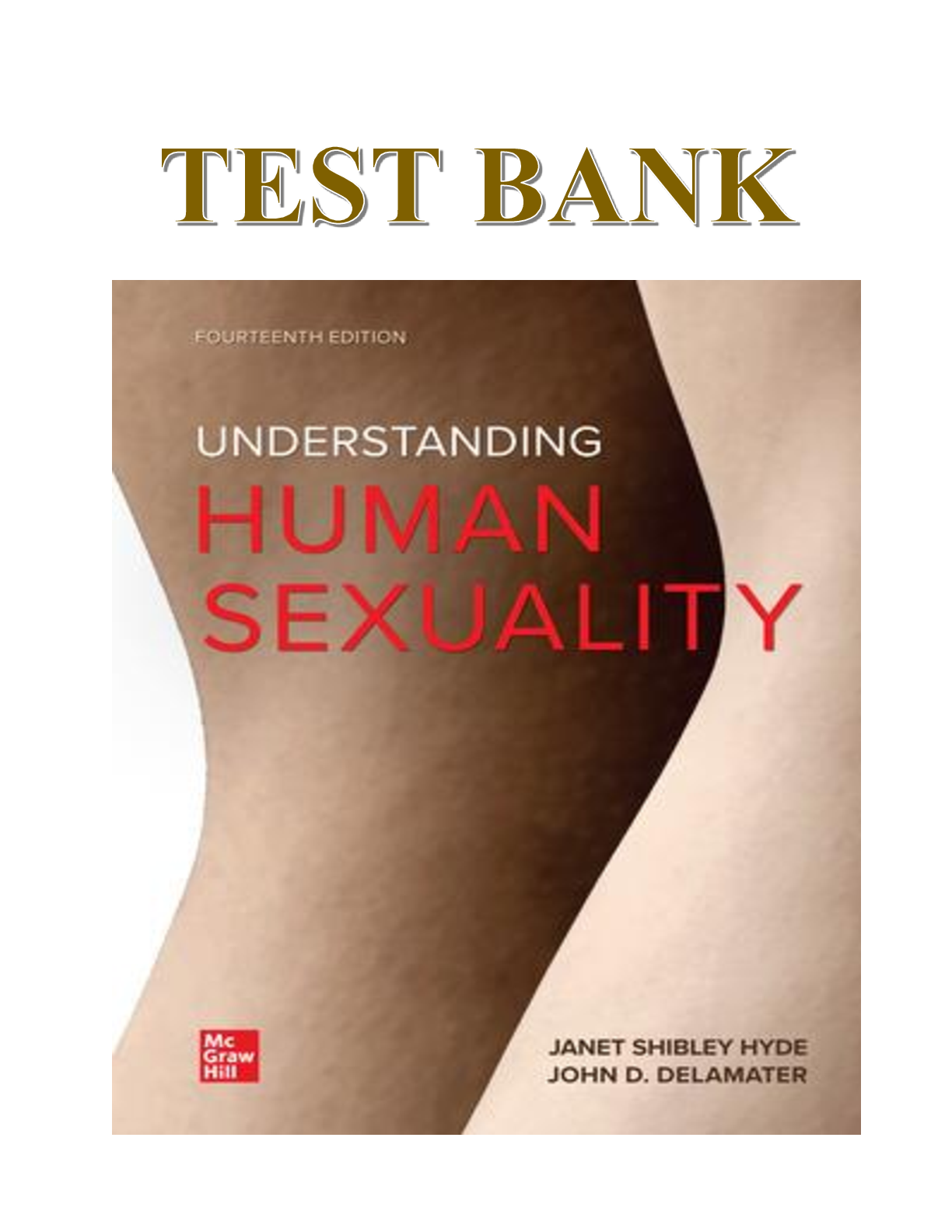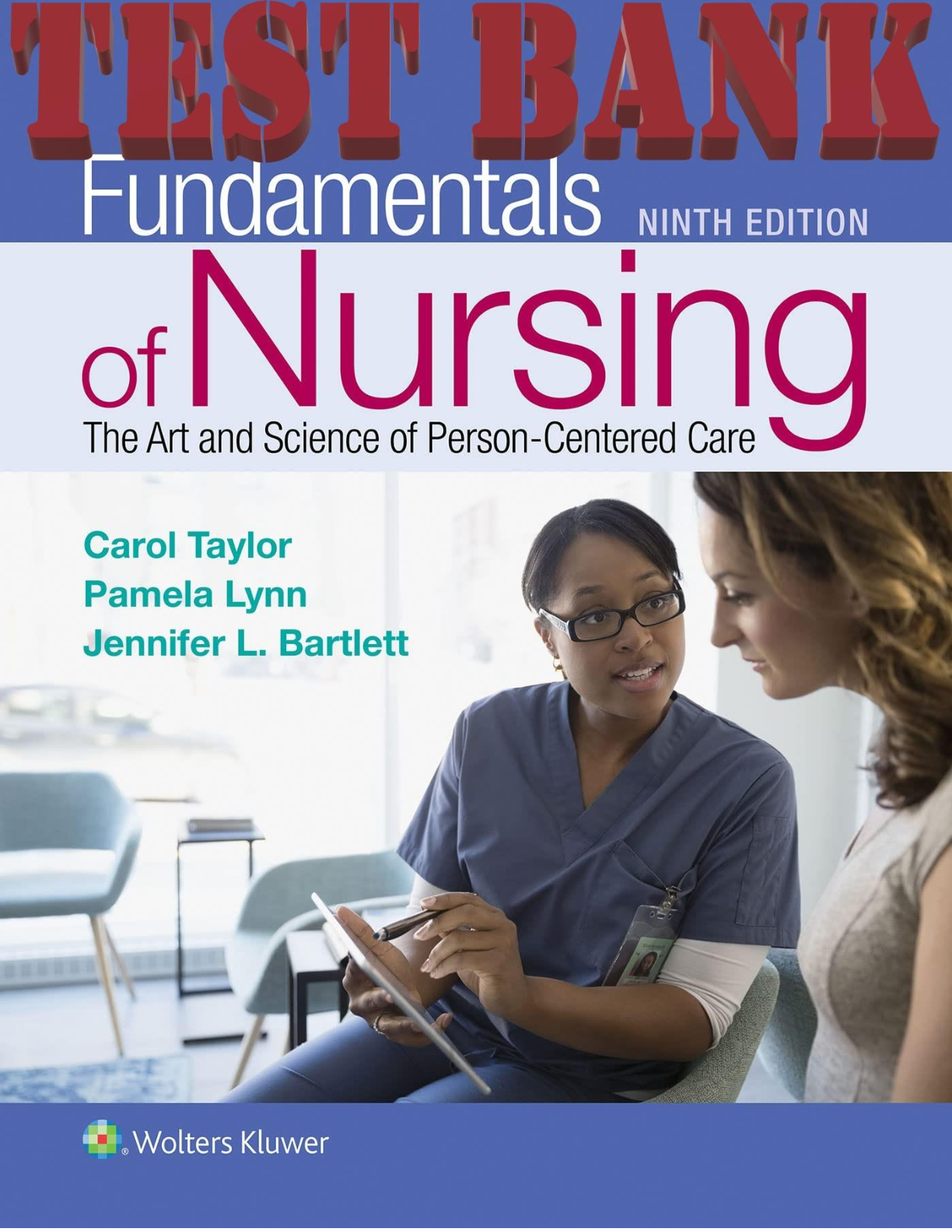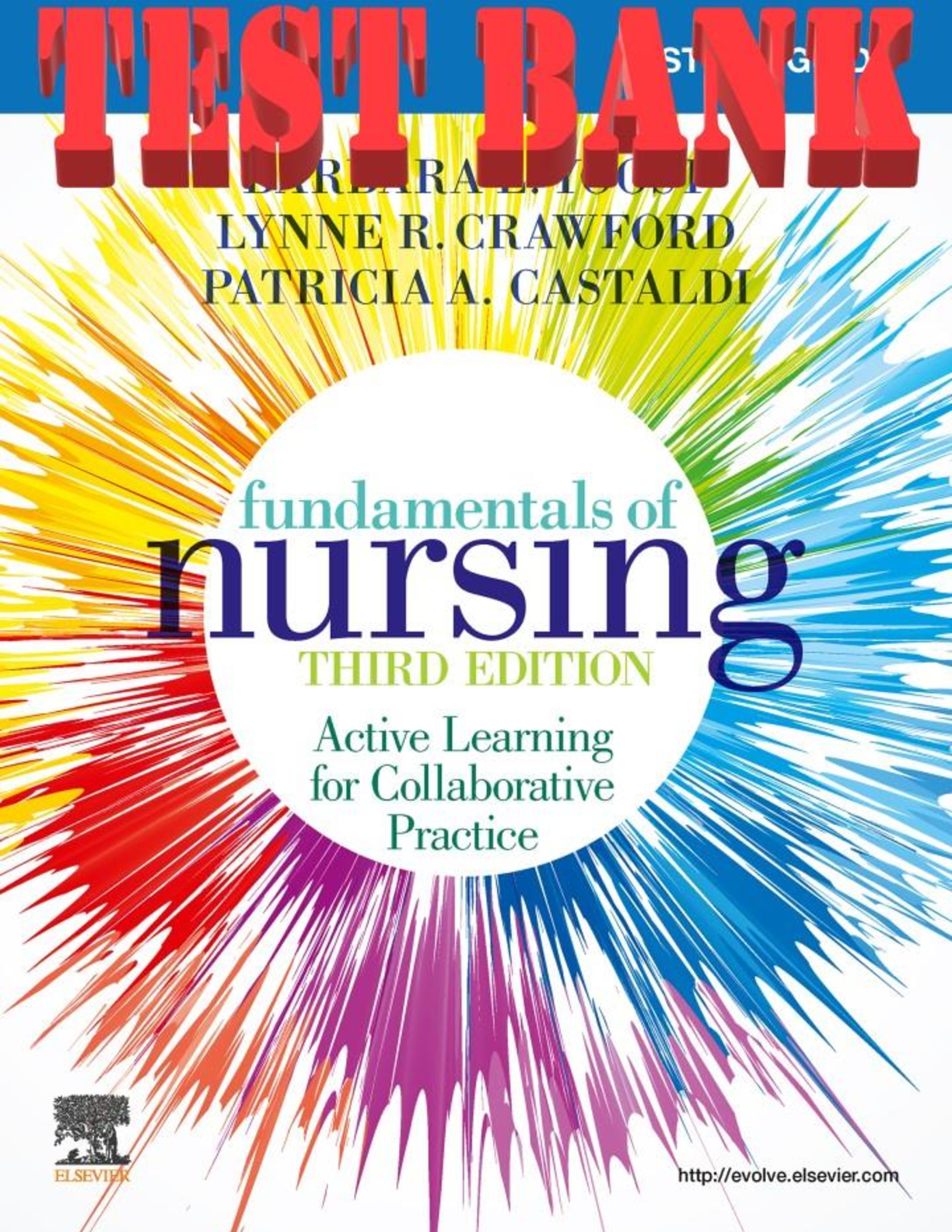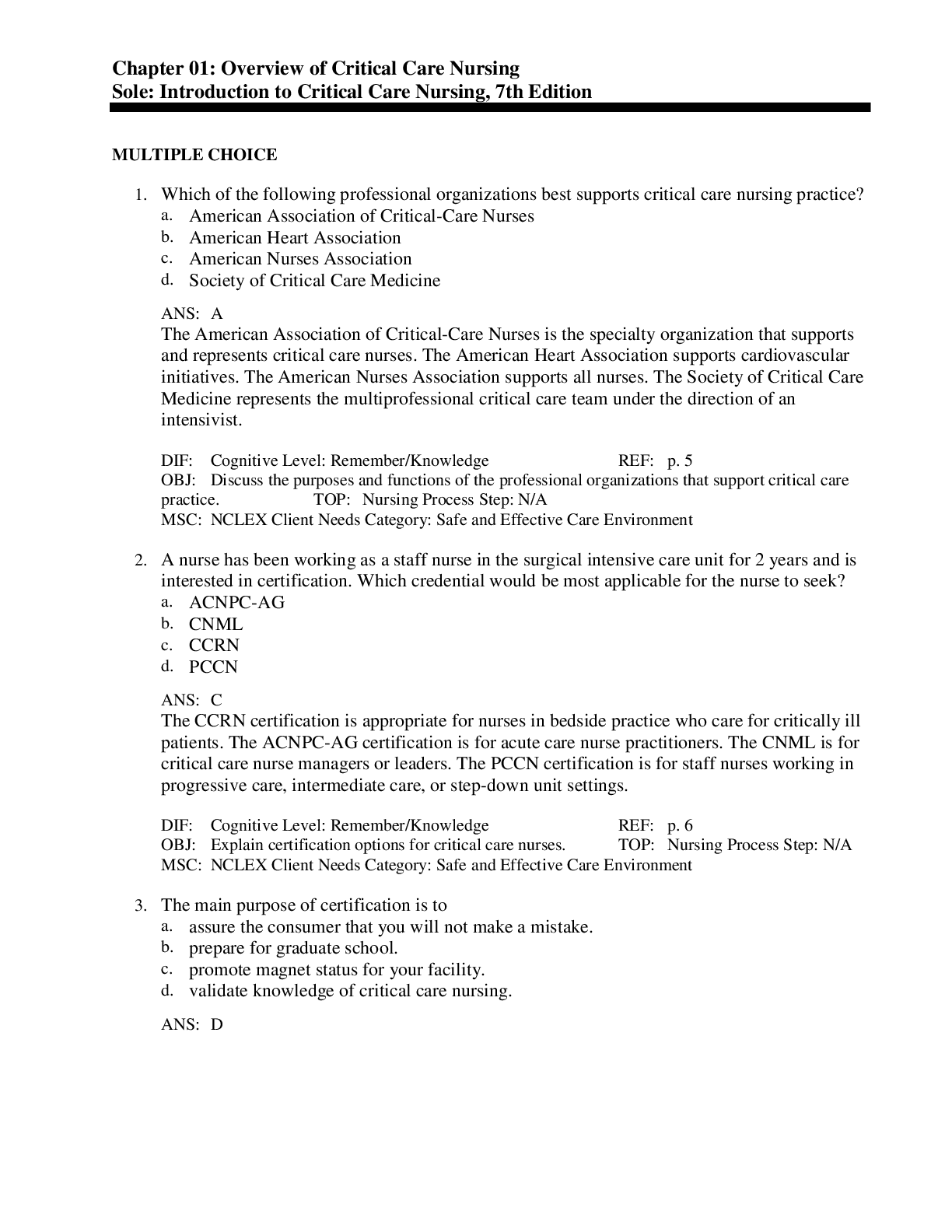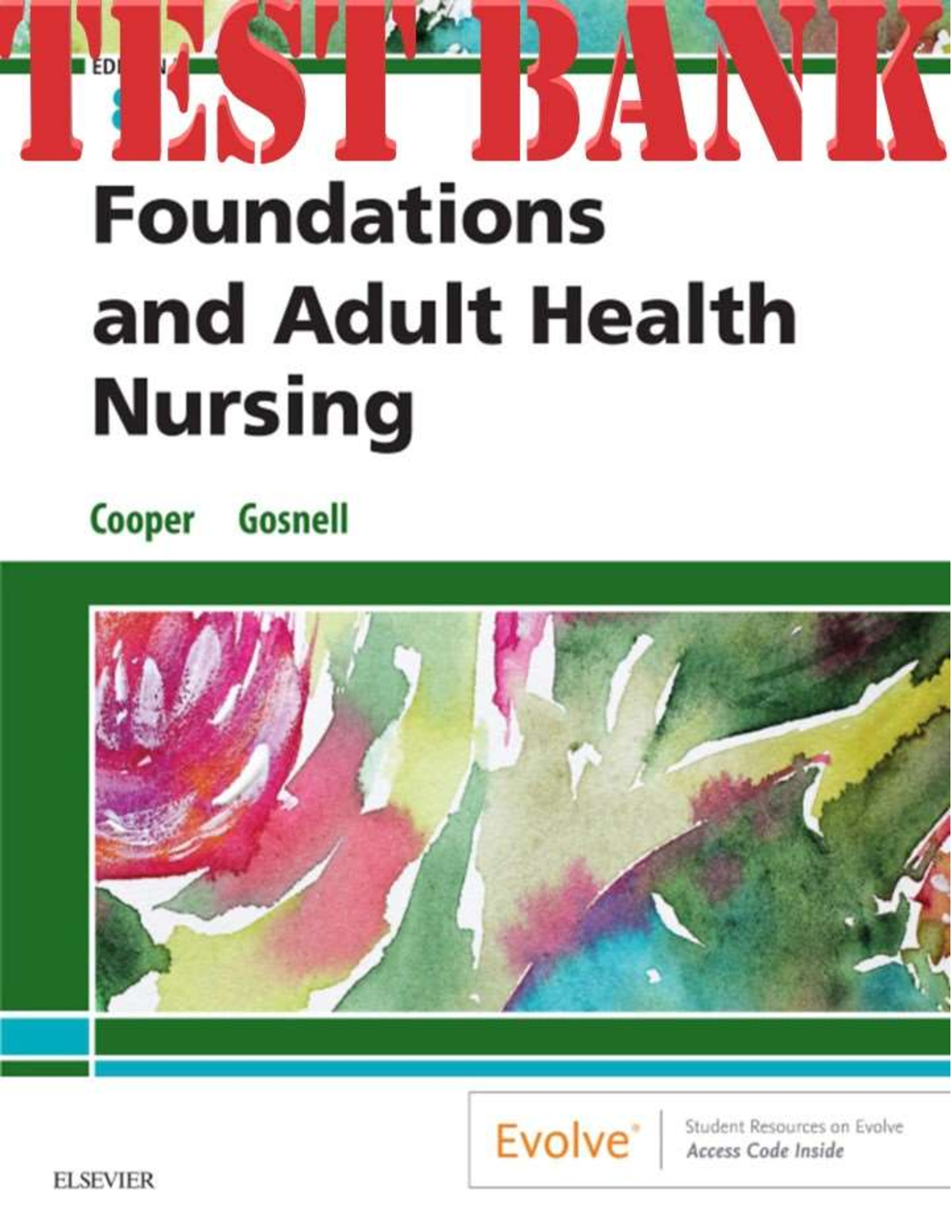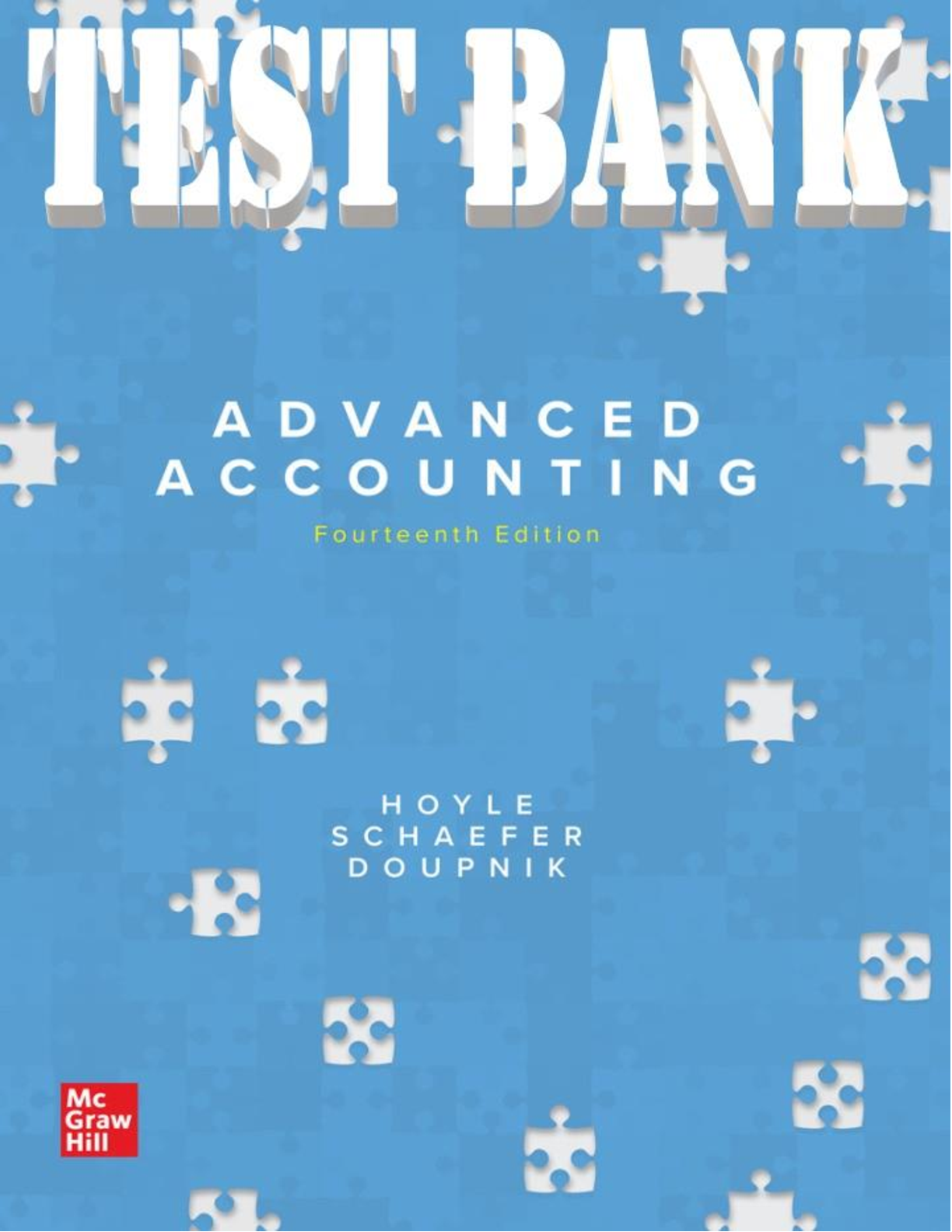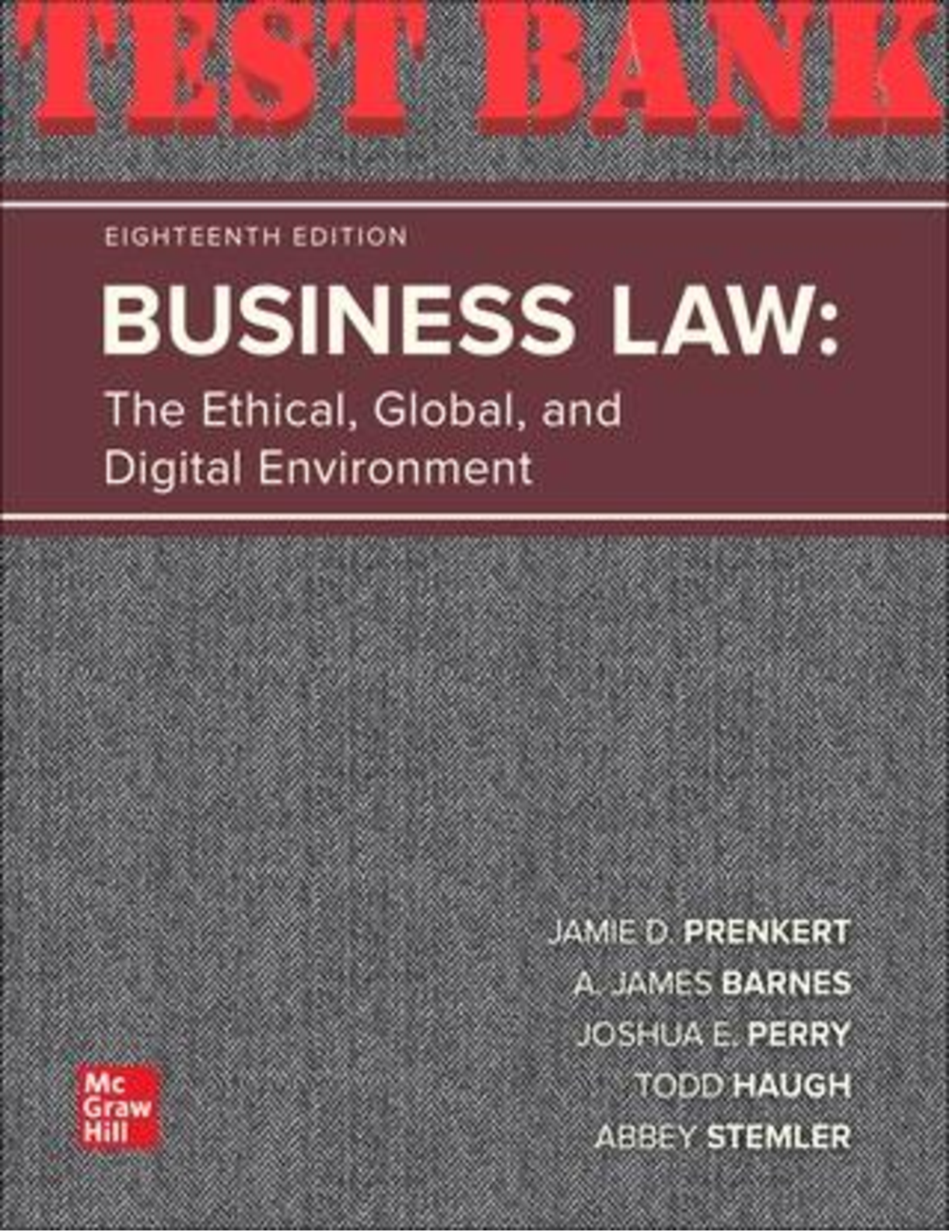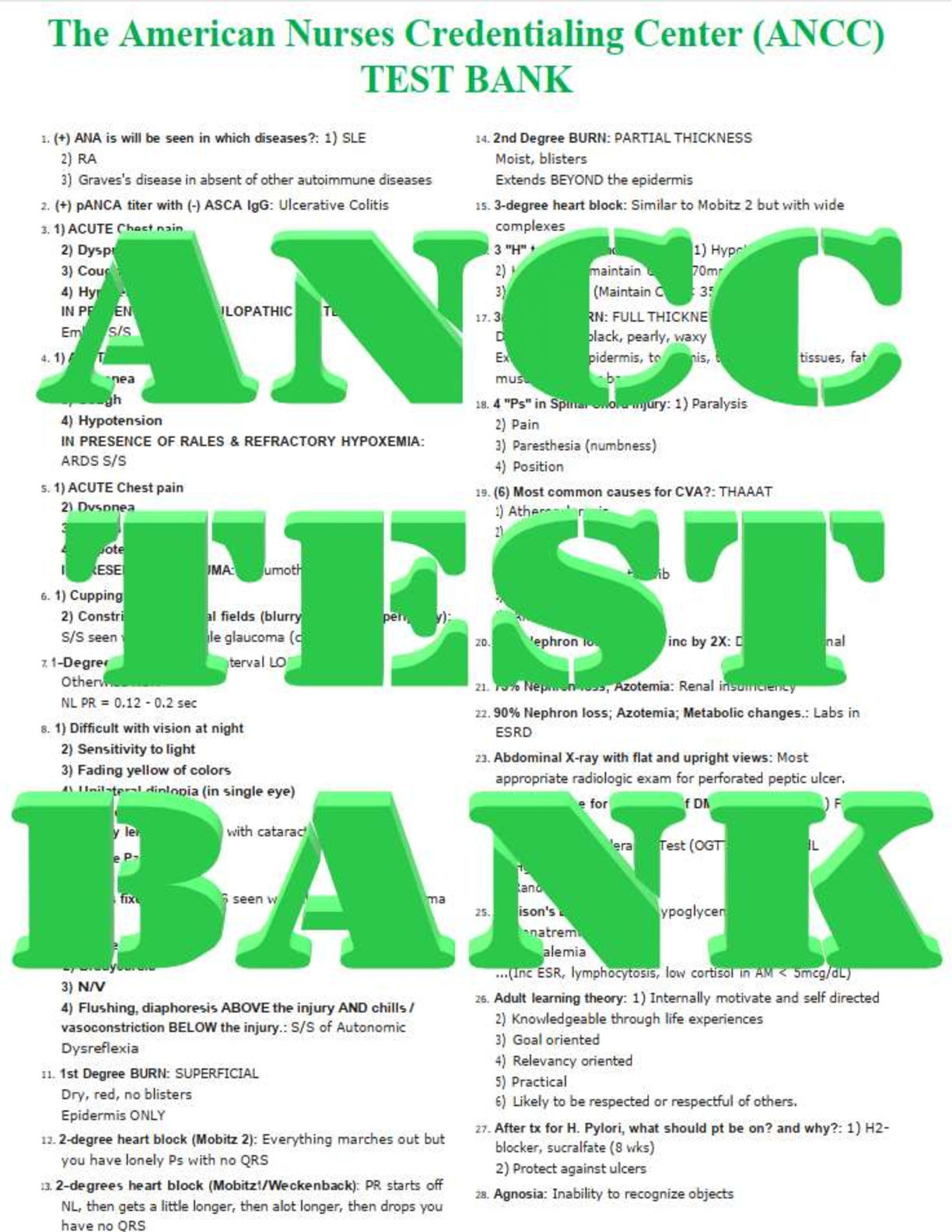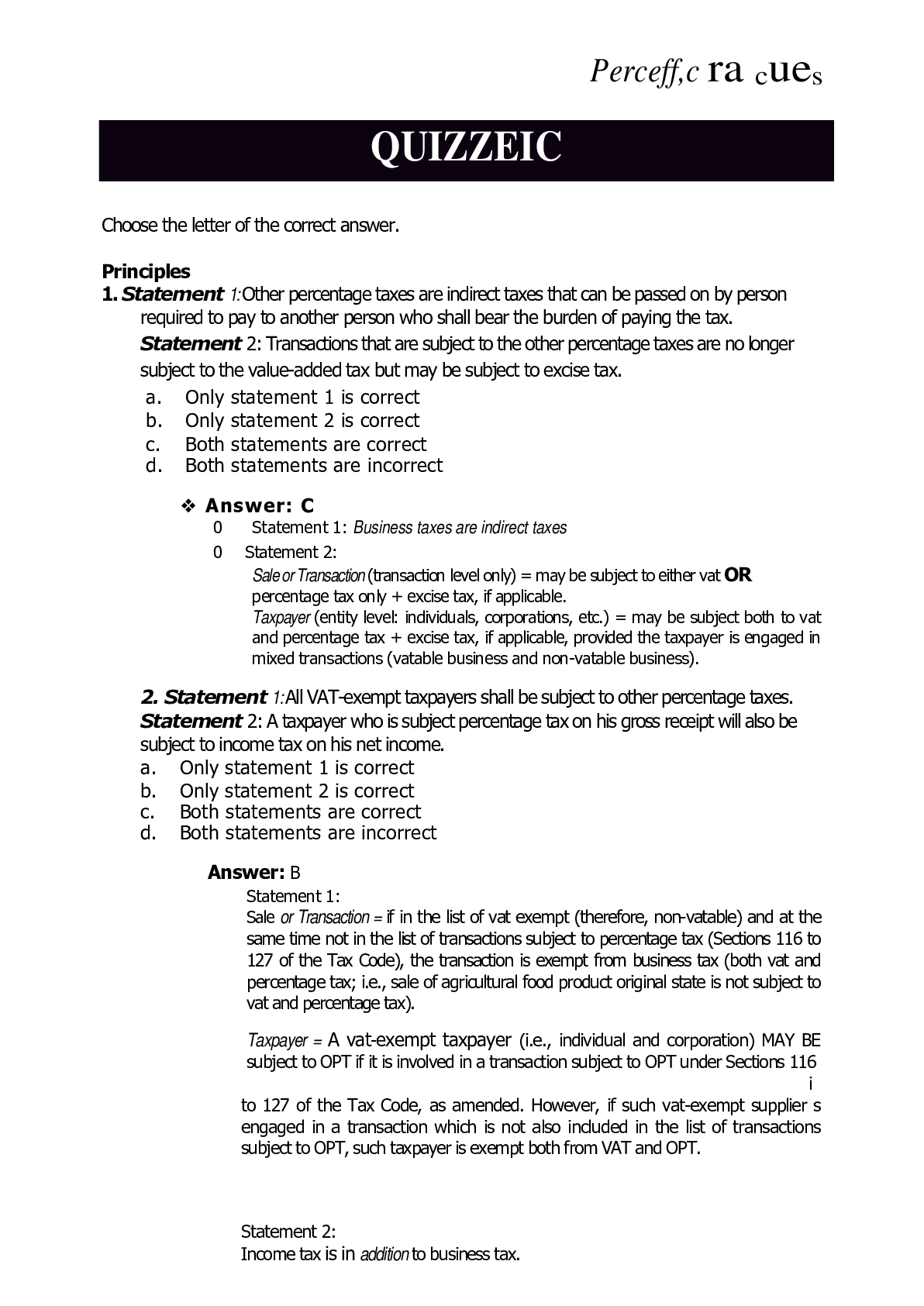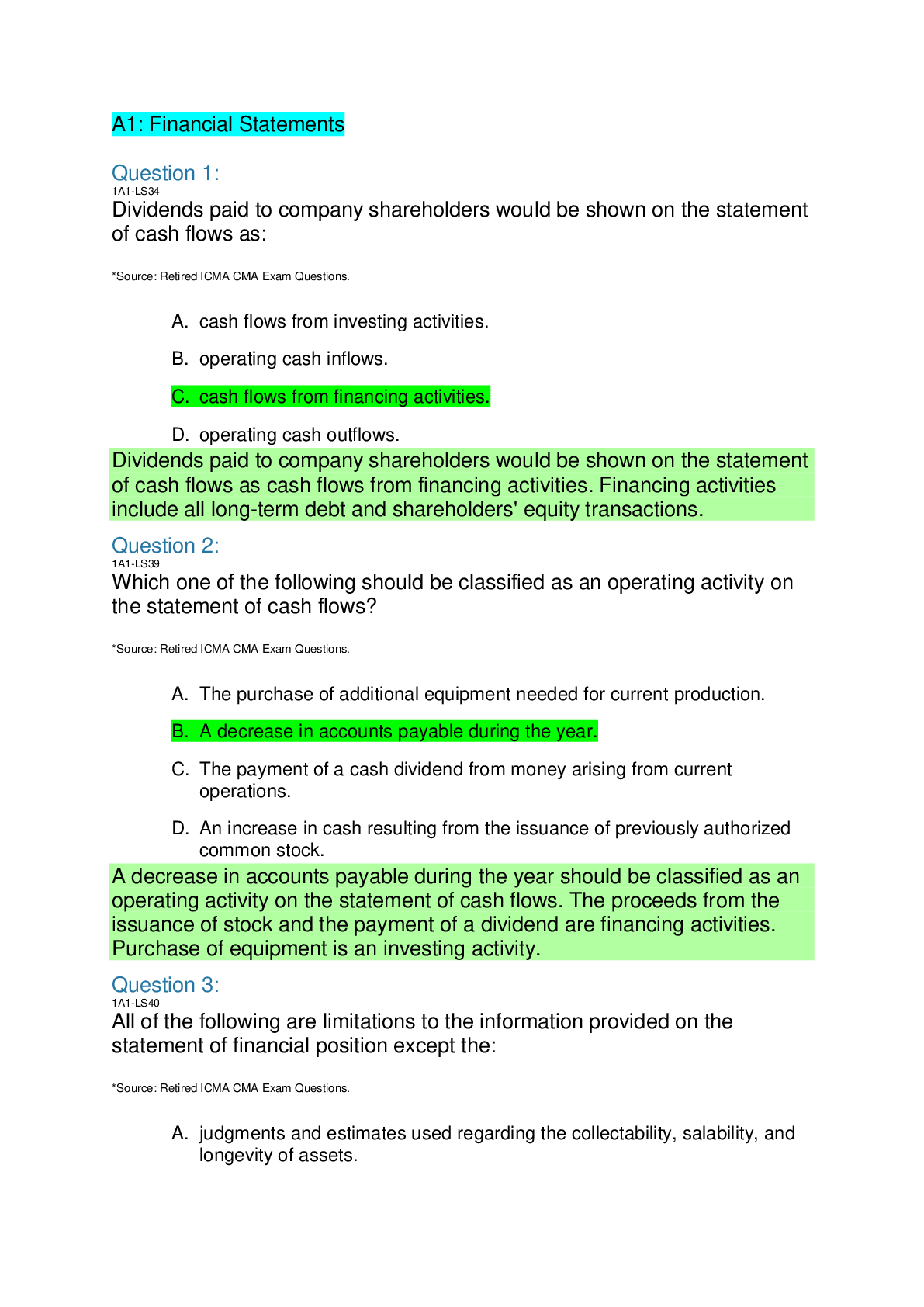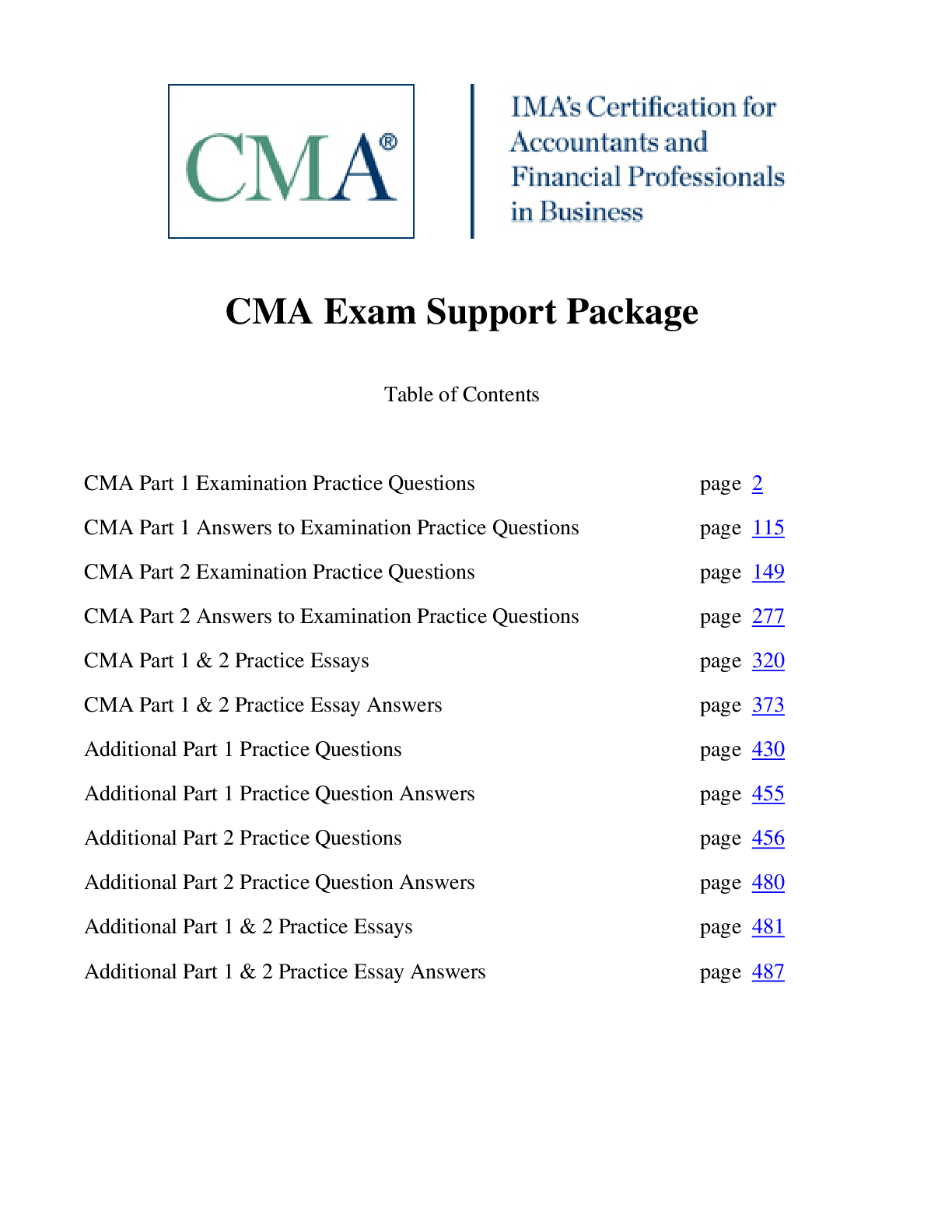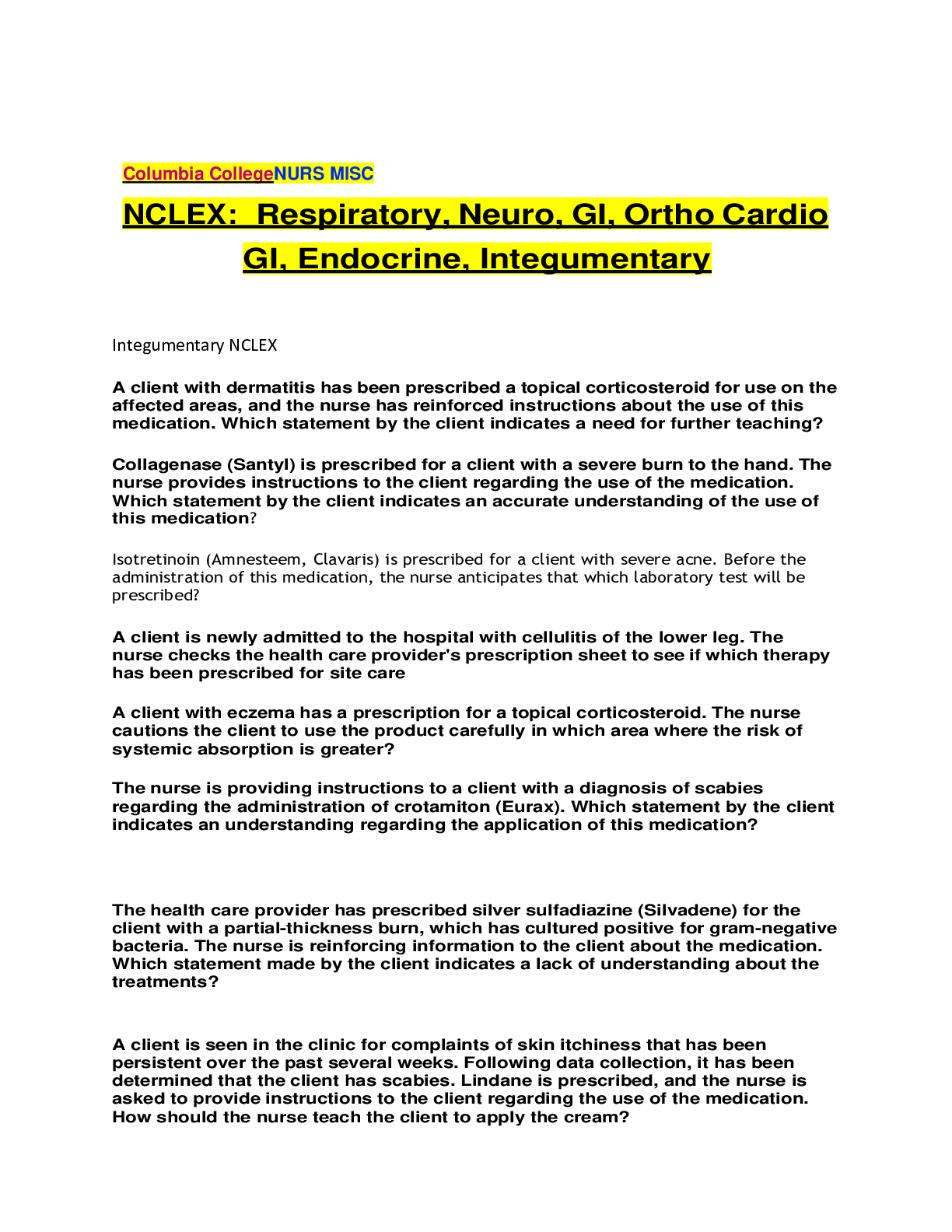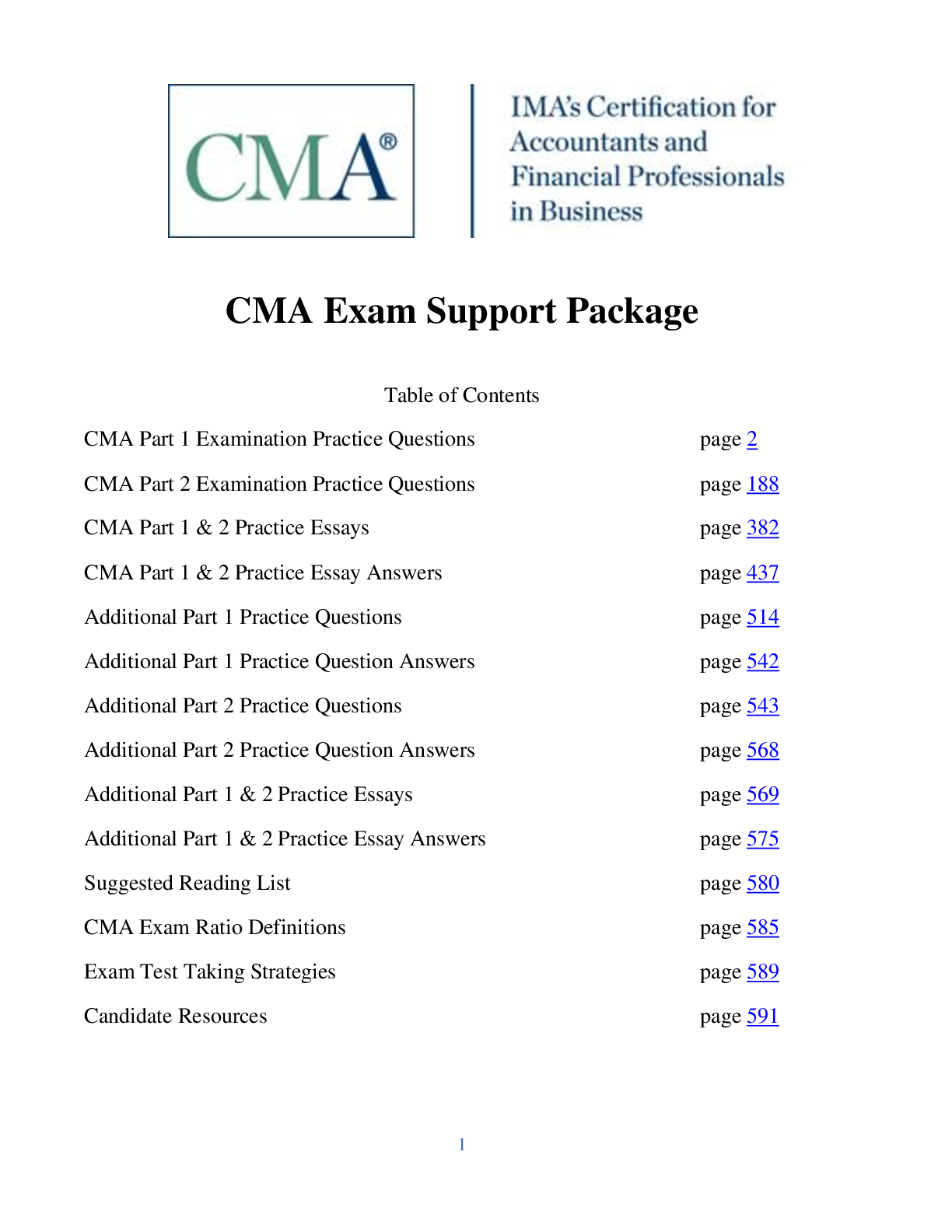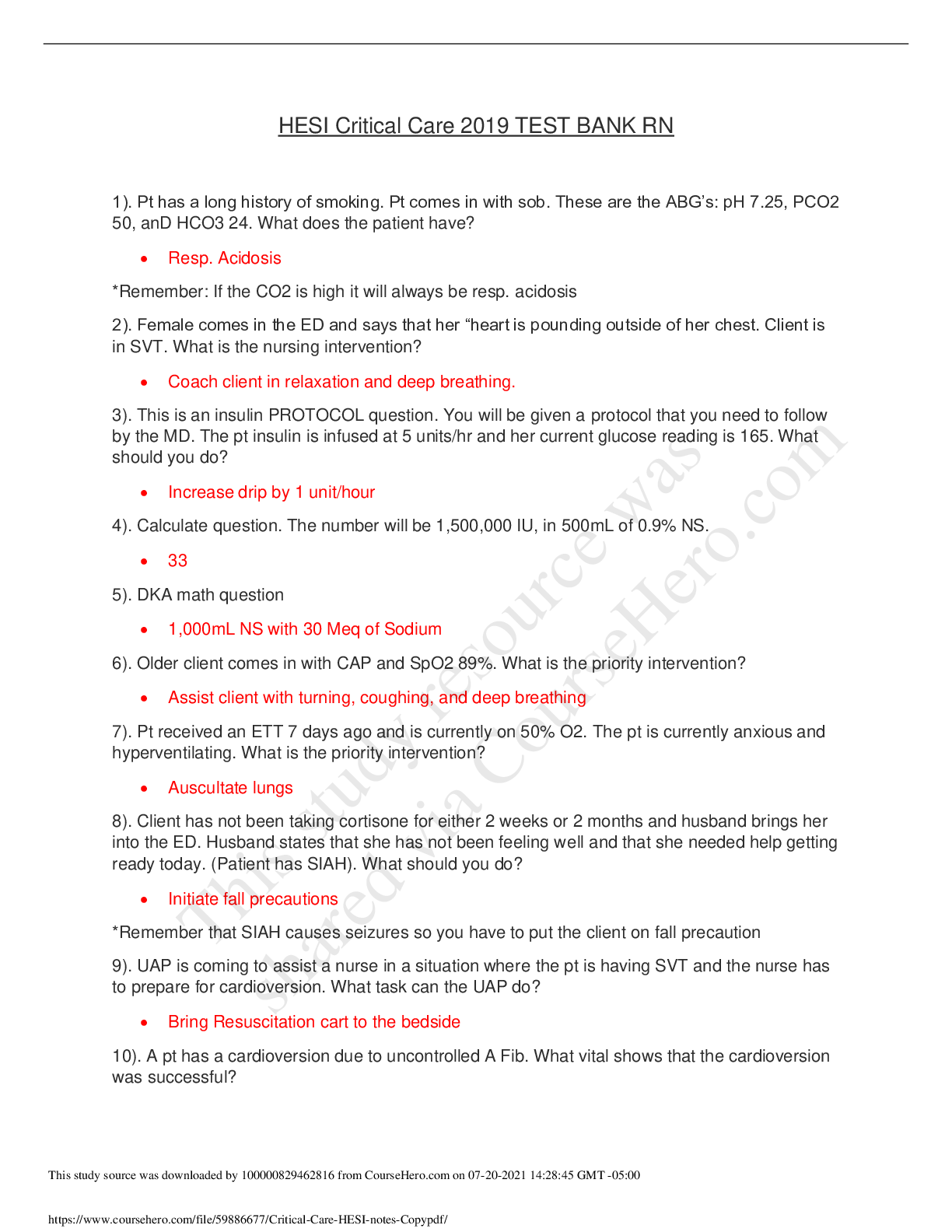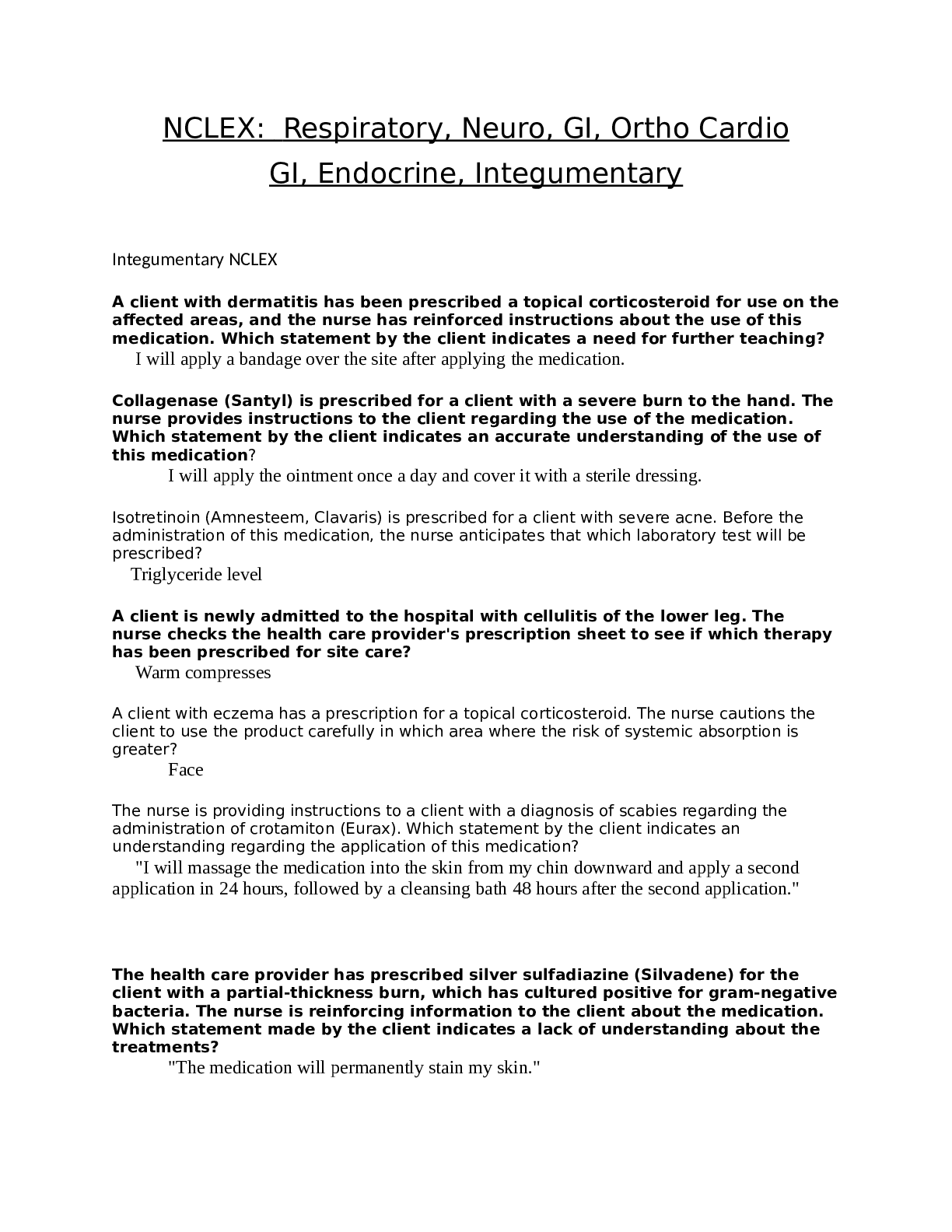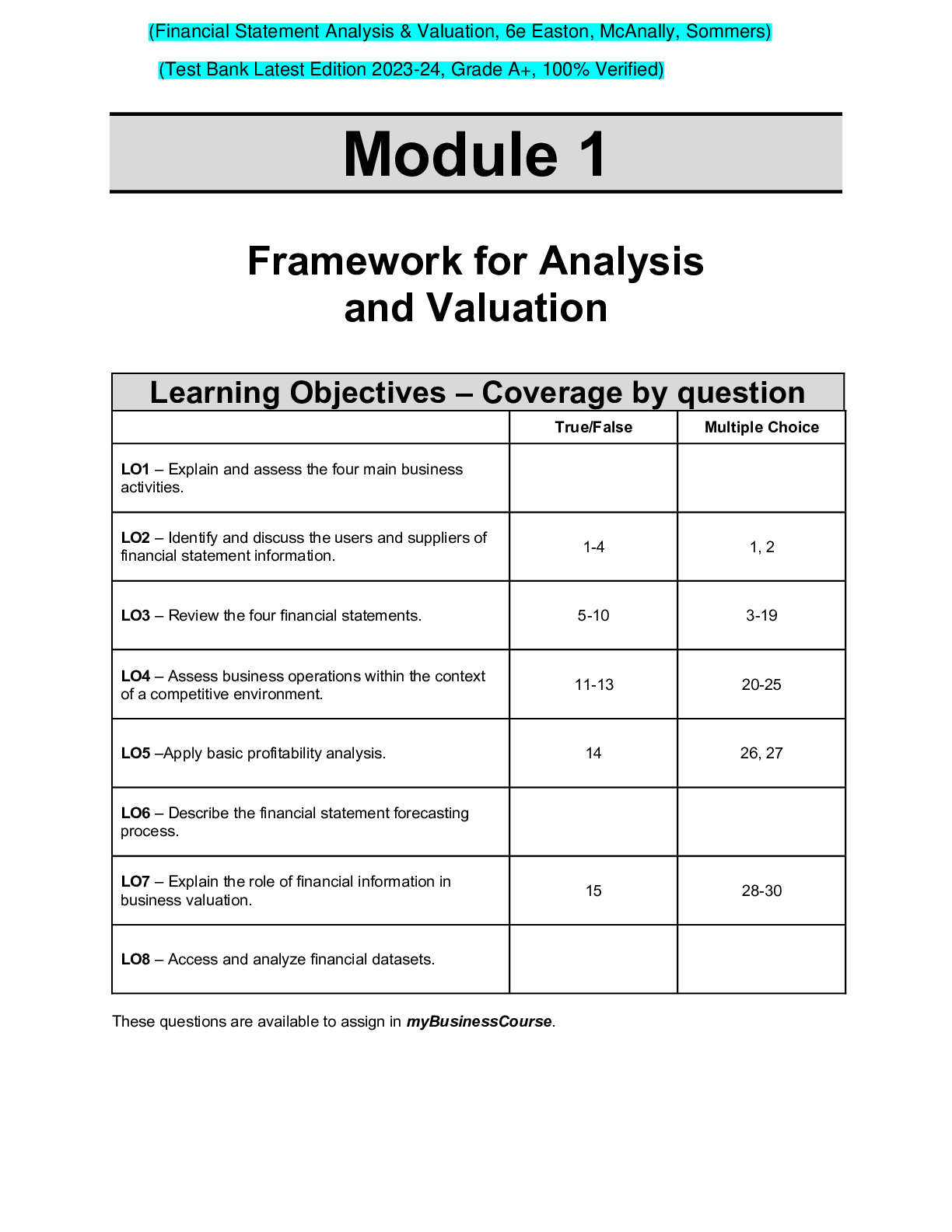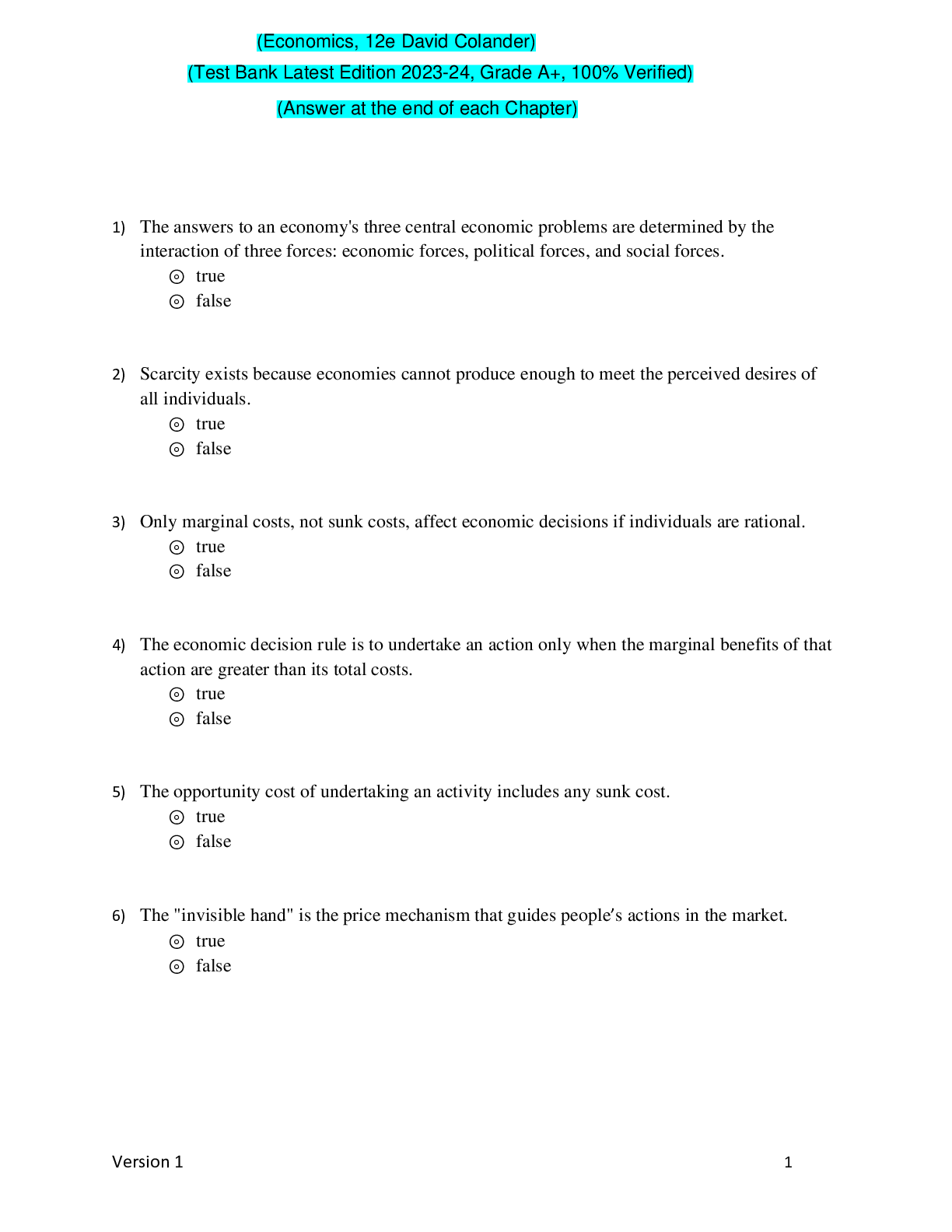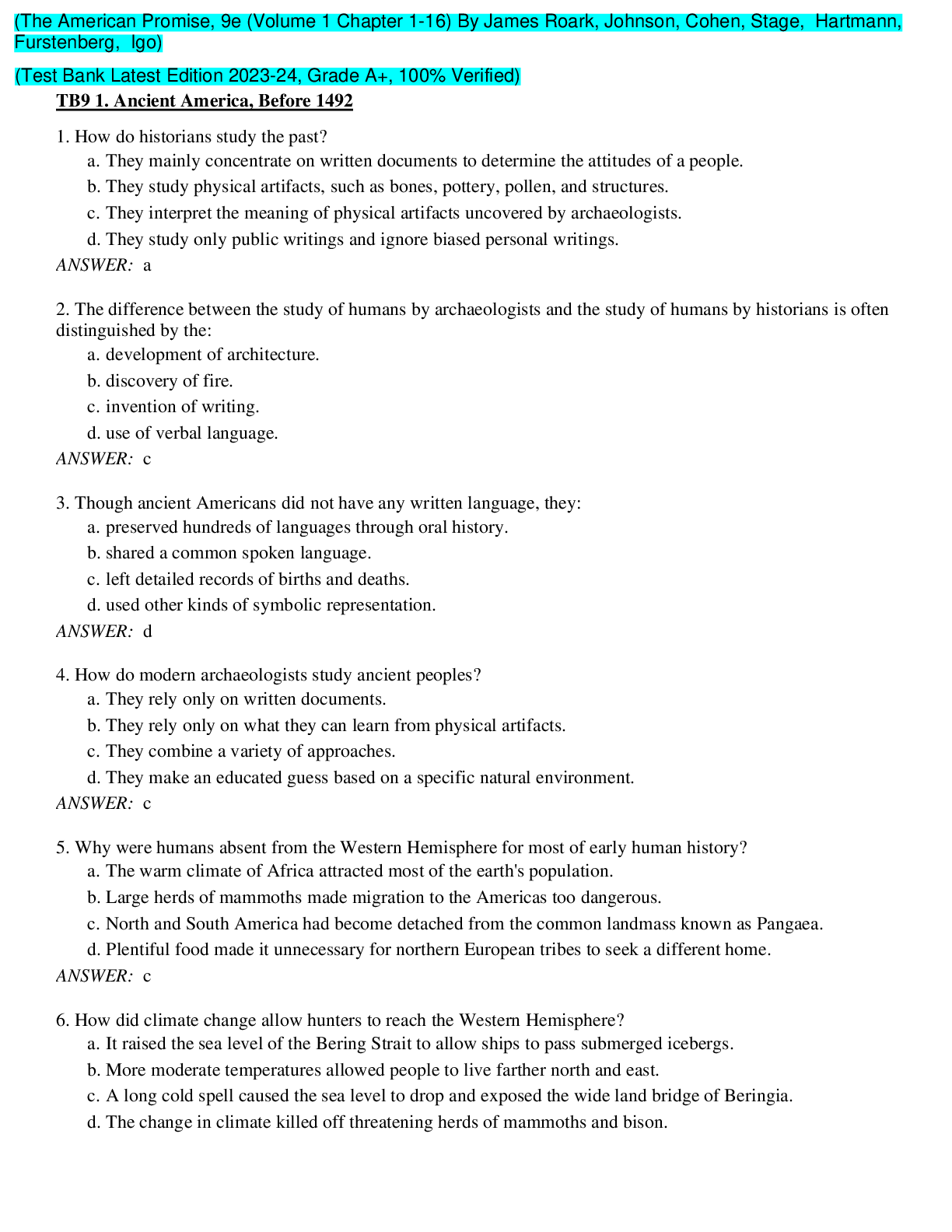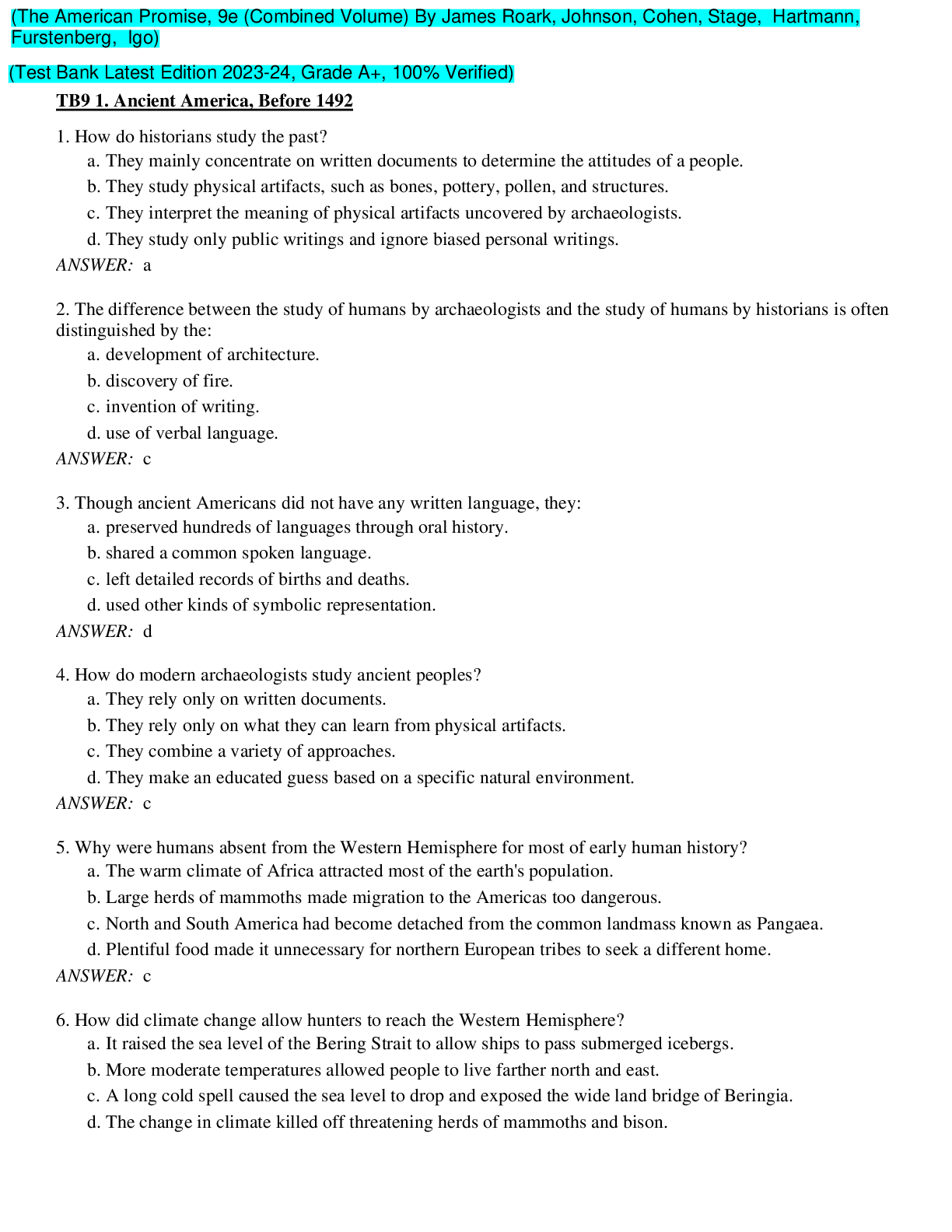*NURSING > TEST BANK > NCLEX Exam TEST BANK Compilation. For Respiratory, Neuro, GI, Ortho Cardio GI, Endocrine, Integument (All)
NCLEX Exam TEST BANK Compilation. For Respiratory, Neuro, GI, Ortho Cardio GI, Endocrine, Integumentary. Contains Over 1000 NCLEX Exam Commonly Tested Questions and Answers.
Document Content and Description Below
NCLEX Exam TEST BANK Compilation. A client with dermatitis has been prescribed a topical corticosteroid for use on the affected areas, and the nurse has reinforced instructions about the use of this ... medication. Which statement by the client indicates a need for further teaching? Collagenase (Santyl) is prescribed for a client with a severe burn to the hand. The nurse provides instructions to the client regarding the use of the medication. Which statement by the client indicates an accurate understanding of the use of this medication? Isotretinoin (Amnesteem, Clavaris) is prescribed for a client with severe acne. Before the administration of this medication, the nurse anticipates that which laboratory test will be prescribed? A client is newly admitted to the hospital with cellulitis of the lower leg. The nurse checks the health care provider's prescription sheet to see if which therapy has been prescribed for site care? A client with eczema has a prescription for a topical corticosteroid. The nurse cautions the client to use the product carefully in which area where the risk of systemic absorption is greater? The nurse is providing instructions to a client with a diagnosis of scabies regarding the administration of crotamiton (Eurax). Which statement by the client indicates an understanding regarding the application of this medication? The health care provider has prescribed silver sulfadiazine (Silvadene) for the client with a partial-thickness burn, which has cultured positive for gram-negative bacteria. The nurse is reinforcing information to the client about the medication. Which statement made by the client indicates a lack of understanding about the treatments? A client is seen in the clinic for complaints of skin itchiness that has been persistent over the past several weeks. Following data collection, it has been determined that the client has scabies. Lindane is prescribed, and the nurse is asked to provide instructions to the client regarding the use of the medication. How should the nurse teach the client to apply the cream? The nurse is applying a topical glucocorticoid on a client with eczema. The nurse monitors for systemic absorption of the medication if the medication is being applied to which body areas? Coal tar has been prescribed for a client with a diagnosis of psoriasis, and the nurse reinforces instructions to the client about the medication. Which statement by the client indicates a need for further teaching? Isotretinoin (Accutane) is prescribed for a client to treat severe cystic acne. The nurse tells the client that the length of the usual prescribed course of treatment is which? Mafenide acetate (Sulfamylon) is prescribed for the client with a burn injury. When applying the medication, the client complains of local discomfort and burning. Which is the most appropriate nursing action? The burn client is receiving treatments of topical mafenide acetate (Sulfamylon) to the site of injury. The nurse monitors the client knowing that which indicates a systemic effect has occurred? Collagenase (Santyl) is prescribed for a client with a severe burn to the hand. The nurse is preparing to reinforce instructions to the client and spouse regarding the wound treatment. Which directions should the nurse include in the instructions? The nurse is assigned to care for a client with a leg ulcer. Sutilains (Travase) treatments are prescribed. The nurse should avoid which action when performing the treatment? A client is undergoing radiation therapy to treat lung cancer. Following the treatment, the nurse notes that the chest and neck are red, and the client is complaining of pain at the radiation site. How should the nurse interpret this data? A client with severe acne is seen in the clinic, and the health care provider (HCP) prescribes isotretinoin (Amnesteem, Clavaris). The nurse reviews the client's medication record and should contact the HCP if the client is taking which medication? The nurse is applying a topical corticosteroid to a client with eczema. The nurse should monitor for the potential for increased systemic absorption of the medication if the medication is being applied to which body area? A client with a burn injury is applying mafenide acetate (Sulfamylon) to the wound. The client calls the health care provider's office and tells the nurse that the medication is uncomfortable and is causing a burning sensation. Which instructions should the nurse reinforce to the client? The nurse reinforces instructions to a client regarding the use of tretinoin (Retin- A). Which statement by the client indicates the need for further teaching? The nurse is caring for a client with a burn injury to the lower legs. Silver sulfadiazine (Silvadene) is prescribed to be applied to the sites of injury. Which indicates the appropriate method to apply this medication? The nurse is caring for a client diagnosed with scabies who has just been prescribed crotamiton (Eurax). The nurse provides which instruction for application of this medication? Salicylic acid is prescribed for a client with a diagnosis of psoriasis. The nurse monitors the client, knowing that which finding indicates the presence of systemic toxicity from this medication? The nurse reviews the laboratory results for a client diagnosed with leukemia who is receiving chemotherapy. The nurse notes that the white blood cell (WBC) count is 2000 cells/mm3. The nurse identifies the finding as indicative of which? The nurse in a health care provider's office has scheduled a client with dermatitis to be seen in 1 week for a patch test. The nurse should reinforce instructions to the client to do which action before the procedure? The clinic nurse is collecting data on a client being admitted. The nurse notes that the client is taking azelaic acid (Azelex). Because of the medication prescription the nurse should suspect that the client is being treated for which condition? 1. An adult client was burned as a result of an explosion. The burn initially affected the client's entire face (the anterior half of the head) and the upper half of the anterior torso, and there were circumferential burns to the lower half of both of the arms. The client's clothes caught on fire, and the client ran, which caused subsequent burn injuries of the posterior surface of the head and the upper half of the posterior torso. According to the rule of nines, what is the extent of this client's burn injury? 2. A client returns to the clinic for follow-up treatment after a skin biopsy of a suspicious lesion that was performed 1 week ago. The biopsy report indicates that the lesion is a melanoma. The nurse understands that which describes a characteristic of this type of a lesion? 3. The nurse is reviewing the health care record of a client with a lesion that has been diagnosed as malignant melanoma. The nurse should expect which characteristic of this type of lesion to be documented in the client's record? 4. The nurse reinforces instructions to a group of clients regarding measures that will assist with the prevention of skin cancer. Which statement by a client indicates the need for further teaching? 5. A client arrives at the emergency department and has experienced frostbite to the right hand. Which should the nurse expect to find when inspecting the client's hand? 6. The evening nurse reviews the nursing documentation in the client's chart and notes that the day nurse has documented that the client has a stage 2 pressure ulcer in the sacral area. Which should the nurse expect to find when checking the client's sacral area? 7. The nurse inspects the skin of a client who is suspected of having psoriasis. Which finding should the nurse note if this disorder is present? 8. Which should be the anticipated therapeutic outcome of an escharotomy procedure performed for a circumferential arm burn? 9. The nurse is caring for a client with circumferential burns of both legs. Which leg position is appropriate for this type of a burn? 10. The nurse is assigned to care for a client with herpes zoster. Which characteristics should the nurse expect to note when checking the lesions of this infection? 11. The nurse is caring for a client with a diagnosis of pemphigus vulgaris. The nurse understands that which is a characteristic of this condition? 12. A client asks the nurse about the causes of acne. The nurse should respond by making which statement to the client? a. " 13. The nurse inspects the oral cavity of a client with cancer and notes white patches on the mucous membranes. The nurse interprets this occurrence as which? 14. The nurse is caring for a client after an autograft of a burn wound on the right knee. Which position should the nurse anticipate being prescribed for the client? 15. The nurse reinforces discharge instructions regarding skin care to a client after the grafting of burn injuries of the left chest and left arm. Which statement by the client indicates the need for further teaching? a. "I 16. The nurse determines that which individual presenting to the clinic is at the greatest risk for development of an integumentary disorder? 17. The nurse is reinforcing discharge instructions to a client who had a skin biopsy. Which statement by the client indicates the need for further teaching? 18. The nurse prepares to assist a health care provider examine the client's skin with a Wood's light. Which action should be included in the plan for this procedure? 19. The nurse reinforces instructions to a client who has complained of chronic dry skin and episodes of pruritus. Which client statement indicates the need for further teaching? 20. A client calls the emergency department and tells the nurse that he has been cleaning a wooded area and that he came into direct contact with poison ivy shrubs. The client tells the nurse that he cannot see anything on the skin and asks the nurse what to do. The nurse makes which statement to the client? a. 21. A client is being admitted to the hospital for the treatment of acute cellulitis of the lower left leg. The client asks the nurse to explain what cellulitis means. Which response should the nurse give to the client's question 22. The nurse prepares to care for a client with acute cellulitis of the lower leg. Which treatment should the nurse anticipate being prescribed for the client? 23. The health care provider suspects a client has herpes zoster. To confirm the diagnosis of herpes zoster, for which diagnostic test does the nurse gather equipment? 24. A client scheduled for a skin biopsy asks the nurse how painful the procedure is. The nurse should make which response to the client? a. "The local anesthetic may cause a burning or stinging sensation." 25. The nurse is checking for the presence of cyanosis in a dark-skinned client. Which body area should provide the best information? 26. The nurse reinforces discharge instructions to a client following patch testing. Which statement by the client indicates the need for further teaching? 27. The nurse prepares to assist in instructing a client about prevention of Lyme disease. Which should the nurse include in the instructions? 28. Following diagnostic evaluation, it has been determined that the client has Lyme disease, stage 2. The nurse understands that which is most indicative of this stage? 29. A client arrives at the health care clinic and tells the nurse that he was just bitten by a tick and would like to be tested for Lyme disease. Which nursing action is appropriate? 30. A client with acquired immunodeficiency syndrome (AIDS) is diagnosed with cutaneous Kaposi's sarcoma. Based on this diagnosis, the nurse understands that this has been determined by which? 31. Which individual is least likely at risk for the development of Kaposi's sarcoma?The nurse reviews a client's chart and notes that the health care provider has documented a diagnosis of paronychia. Based on this diagnosis, which should the nurse expect to note during data collection? 32. The nurse is assigned to assist in caring for a client with frostbite of the toes. Which should the nurse anticipate to be prescribed for this condition? 33. The nurse is checking her clients for skin breakdown. Which client should have the lowest priority for concern in the development of skin breakdown? 34. A client is undergoing radiation therapy to treat lung cancer. Following the treatment, the nurse notes that the chest and neck are red, and the client is complaining of pain at the radiation site. How should the nurse interpret this data? a. 35. Sodium hypochlorite (Dakin's solution) is prescribed for a client with a leg wound containing purulent drainage. The nurse is assisting in developing a plan of care for the client and includes which in the plan? a. 36. Collagenase (Santyl) is prescribed for a client with a severe burn to the hand. The nurse provides instructions to the client regarding the use of the medication. Which statement by the client indicates an accurate understanding of the use of this medication? a. 37. The nurse inspects a pressure ulcer on a client's sacrum and notes that the ulcer has partial-thickness skin loss and the formation of a blister. The nurse should document the ulcer as which category? a. 38. A client is receiving topical corticosteroid therapy in the treatment of psoriasis. The nurse expects the health care provider to prescribe which measure to maximize the effectiveness of this therapy? a. 39. Which individuals is least likely at risk for the development of psoriasis? a. 40. The nurse is assisting in caring for a client with a severe burn who has just received an autograft to the knee area of the right leg. The nurse plans to keep the right leg in which position? a. 41. A client with a burn injury is scheduled for a heterograft. The nurse is preparing the client for the skin grafting, and the client asks the nurse what "heterograft" means. Which is the most appropriate response to the client? a. " 42. The nurse is caring for a client who sustained burns on the entire right leg and anterior thorax. Using the rule of nines, the extent of the burn injury would be which percentage? a. 43. A client enters the ambulatory clinic, stating she has just been stung by a bee. Her vital signs are stable, and she has no previously known allergy to bee stings. The "stinger" is still visible in her arm. What should be the nurse's first action? a. 44. A client had a radical neck dissection with a musculocutaneous flap. Twenty-four hours following the procedure, the nurse observes that the flap has a slightly blue hue. The nurse draws which conclusion? a. . 45. A client has a non-infected pressure ulcer on the left heel. The nurse should use which sterile solutions to cleanse the wound as part of a dressing change procedure? a. 46. A client sustains a burn injury to the entire right and left arms, right leg, and anterior thorax. According to the rule of nines, the nurse should determine that this injury constitutes which body percentage? 47. The nurse is assigned to care for a client with partial-thickness burns to 60% of her body surfaces. On the fourth day after injury, the client's vital signs include an oral temperature of 102.8° F, pulse of 98 beats per minute, respirations of 24 breaths per minute, and blood pressure of 105/64 mm Hg. Parenteral nutrition is infusing at 82 mL/hr. Based on these data, the nurse plans to initially perform which action? a. 48. The nurse reinforces home care instructions with a client diagnosed with impetigo. Which statement indicates the need for further teaching about the measures that will prevent the spread of infection? a. 49. A client, admitted to the emergency department, is suspected of having frostbite of the hands. Which finding should the nurse note in this condition? a. 50. Which clients are at risk for developing skin breakdown? Select all that apply. a. 51. The nurse notes that a client is due in hydrotherapy for a burn dressing change in 30 minutes. The nurse plans to take which action next in the care of this client? a. 52. A client with chronic dermatitis has decided to receive testing to determine the cause of the condition. A patch test will be performed at the scheduled clinic visit in 2 weeks. The nurse reinforces instructions to the client regarding preparation for the test. Which statement by the client indicates an understanding regarding the preparation for this procedure? a. 53. The nurse is reviewing the health care provider's prescriptions written for a client admitted with a diagnosis of acute cellulitis of the lower leg. The nurse should question which prescription? a. 54. The nurse is assessing the skin on a client who is immobile and notes the presence of a stage 2 pressure ulcer in the sacral area. Which nursing actions will encourage healing of a stage 2 pressure ulcer? Select all that apply. a. Clean with mild soap and water. b. Encourage adequate nutritional intake. c. Apply a dressing that allows oxygen to pass through. 55. A client with a burn injury begins to cry and states to the nurse, "I don't want anyone seeing me. I look awful." The nurse determines that the client is experiencing which associated problem? a. 56. An older client is transferred to the nursing unit following a graft to a stage 4 pressure ulcer. Which combination of dietary items should the nurse encourage the client to eat to promote wound healing? a. 57. The nurse is preparing a client for skin grafting and identifies that the health care provider has documented that the client is scheduled for a heterograft. The nurse understands that a heterograft used for the burn client is skin from which source? a. 58. During the inspection of a client's skin, the nurse notes redness and an abrasion type wound on the sacrum area. The nurse determines that this finding is indicative of which stage of pressure ulcer? a. 59. After 7 days of wound care, a client who has a well-granulated pressure ulcer reports to the nurse, "I'm feeling better overall." Which nursing intervention most likely contributed to the client's feelings? a. 60. Using the rule of nines, calculate the burn percentage for the client. Refer to the figure; the burned area is the darkly shaded area. Fill in the blank. Refer to figure. 61. A client comes to a health care provider's office complaining of a bite on the arm. The client reports that he recently removed a tick from the same location. Which characteristic is a classic sign of Lyme disease that can result from an infected tick? a. 62. A client with jaundice is complaining of pruritus. Which strategy should the nurse institute to help control the problem and prevent injury? a. . 63. The nurse inspects the skin of a client receiving external radiation therapy and documents a finding as moist desquamation. The nurse understands that moist desquamation is best described as which? a. 64. The nurse is discussing skin biopsy with a client scheduled for the procedure. The nurse tells the client to expect which amount of discomfort during the procedure? a. 65. The nurse in a health care provider's office has scheduled a client with dermatitis to be seen in 1 week for a patch test. The nurse should reinforce instructions to the client to do which action before the procedure? a. 66. An adult client trapped in a burning house suffered burns to the back of the head, the upper half of the posterior trunk, and the back of both arms. Using the rule of nines, the nurse determines the extent of the burn injury to be which percentage? A 67. A client has sustained partial-thickness burns on the posterior thorax and legs. The nurse who is assisting in caring for the client should monitor for which sign/symptom during the first 24 hours after the burn injury? a. 68. An older client is complaining of chronic dry skin and occasional pruritus. The nurse reinforces instructions for the client to avoid which skin care regimen that will aggravate the condition? a. 69. A client is newly admitted to the hospital with cellulitis of the lower leg. The nurse checks the health care provider's prescription sheet to see if which therapy has been prescribed for site care? a. 70. The nurse is preparing a poster for a health fair about prevention and early detection of skin cancer. The nurse should include on the poster instructions to avoid which activities? a. 71. A client with psoriasis has been prescribed coal tar for use in the treatment of the disorder. In reinforcing instructions to the client about the medication, the nurse incorporates which aspect of this medication? a. Can stain the skin and hair 72. The nurse is caring for a client on transmission-based precautions who has herpes zoster or shingles. Which are some of the most important skin issues associated with this condition? Select all that apply. a. Full-thickness skin necrosis can result. b. Lesions are very contagious when they are fluid-filled blisters. c. Eruptions can last several weeks, and the severe pain (postherpetic neuralgia) often persists after the lesions have resolved. d. To reduce the risk of transmitting the virus to others, keep clients with lesions separated from other clients until lesions have crusted. 73. The nurse is conducting a focused evaluation on a postoperative client's integumentary system. Which priority objective physical examination assessments are related to inspection? Select all that apply. a. b. Nails for shape, contour, color, thickness and cleanliness c. Skin for color, integrity, scars, lesions, and signs of breakdown d. Facial and body hair for distribution, color, quantity and hygiene 74. The nurse is caring for a postoperative client. The nurse knows that the primary processes of normal wound healing include which phases? Select all that apply. a. Inflammatory or (lag) phase b. Maturation or (remodeling) phase c. Proliferative or (connective tissue repair) phase 75. The nurse is working on a surgical unit. Which surgical clients are most at risk for wound infection? Select all that apply. a. Wound from repair of a perforated appendix b. Gunshot wound that punctured the small intestine c. Traumatic wound to the abdomen and intentionally left open for several days d. Wound related to debridement of a chronic pressure ulcer resulting in a cavity-like defect 76. An African-American client has been admitted for a skin rash on his lower back. Which should the nurse rely on when assessing the skin rash? Select all that apply. a. Palpation b. Induration 1. After a liver biopsy, the nurse should place the client in which position? 2. The nurse is assisting with the insertion of a nasogastric tube into a client. The nurse should place the client in which position for insertion? 3. The nurse is checking a client for the correct placement of a nasogastric (NG) tube. The nurse aspirates the client's stomach contents and checks its pH level. Which pH value indicates the correct placement of the tube? 4. A licensed practical nurse (LPN) is preparing to assist a registered nurse (RN) with removing a nasogastric (NG) tube from the client. The LPN should reinforce instructing the client to perform which action? Take and hold a deep breath. 5. The nurse is caring for a client with a diagnosis of chronic gastritis. The nurse anticipates that the client is at risk for which vitamin deficiency? Vitamin B12 6. The nurse is caring for a client after a Billroth II (gastrojejunostomy) procedure. On review of the postoperative prescriptions, which should the nurse clarify? 7. The nurse is reinforcing discharge instructions to a client after a gastrectomy. Which measure should the nurse include in client teaching to help prevent dumping syndrome? 8. The nurse is monitoring a client for the early signs and symptoms of dumping syndrome. Which indicates this occurrence? 9. The nurse is reviewing the record of a client with Crohn's disease. Which stool characteristic should the nurse expect to see documented in the record? 10. The nurse is reviewing the prescriptions of a client admitted to the hospital with a diagnosis of acute pancreatitis. Which interventions should the nurse expect to note? Select all that apply. Administer antacids as prescribed Encourage coughing and deep breathing. Administer anticholinergics, as prescribed. 11. It has been determined that a client with hepatitis has contracted the infection from contaminated food. Which type of hepatitis is this client most likely experiencing? 12. The nurse is reviewing the health care provider's prescriptions written for a client admitted with acute pancreatitis. Which health care provider prescription should the nurse verify if noted in the client's chart? 13. A client with hiatal hernia chronically experiences heartburn after meals. Which should the nurse teach the client to avoid? 14. The nurse is monitoring for stoma prolapse in a client with a colostomy. Which stoma observation should indicate that a prolapse has occurred? 15. Before administering an intermittent tube feeding through a nasogastric tube, the nurse checks for gastric residual volume. Which is the best rationale for checking gastric residual volume before administering the tube feeding? 16. The nurse observes that a client with a nasogastric tube connected to continuous gastric suction is mouth breathing, has dry mucous membranes, and has a foul breath odor. In planning care, which nursing intervention would be best to maintain the integrity of this client's oral mucosa? 17. A client with acute pancreatitis is experiencing severe pain from the disorder. The nurse tells the client to avoid which position that could aggravate the pain? 18. The nurse is evaluating the effect of dietary counseling on the client with cholecystitis. The nurse determines that the client understands the instructions given if the client states that which food item is acceptable to include in the diet? 19. A client is admitted to the hospital with acute viral hepatitis. Which sign/symptom should the nurse expect to note based on this diagnosis? A 20. Which infection control method should be the priority to include in the plan of care to prevent hepatitis B in a client considered to be at high risk for exposure? 21. A client is admitted to the hospital with viral hepatitis and is complaining of a loss of appetite. In order to provide adequate nutrition, which action does the nurse encourage the client to take? 22. The nurse is caring for a client with acute pancreatitis and a history of alcoholism and is monitoring the client for complications. Which data should be indicative of paralytic ileus? 23. A client with viral hepatitis has no appetite, and food makes the client nauseated. Which nursing intervention should be appropriate? . 24. The nurse is participating in a health screening clinic and is preparing materials about colorectal cancer. The nurse plans to include which risk factor for colorectal cancer in the material? Personal history of ulcerative colitis or gastrointestinal (GI) polyps A client has undergone esophagogastroduodenoscopy (EGD). The nurse places highest priority on which action as part of the client's care plan? 25. The nurse is collecting data from a client admitted to the hospital with a diagnosis of suspected gastric ulcer and is asking the client questions about pain. Which statement made by the client supports the diagnosis of gastric ulcer? 26. A client has been diagnosed with acute gastroenteritis. Which diet should the nurse anticipate to be prescribed for the client? 27. A client has asymptomatic diverticular disease. Which type of diet should the nurse anticipate being prescribed? 28. The nurse is caring for a client suspected of having appendicitis. Which should the nurse anticipate will be prescribed for this client? 29. The nurse has given the client with hepatitis instructions about postdischarge management during convalescence. The nurse determines that the client needs further teaching if the client makes which statement? 30. The nurse is assigned to care for a client who had a Sengstaken-Blakemore tube inserted when more conservative treatment failed to alleviate the condition. The nurse should suspect that the client has which diagnosis? [Show More]
Last updated: 9 months ago
Preview 1 out of 191 pages
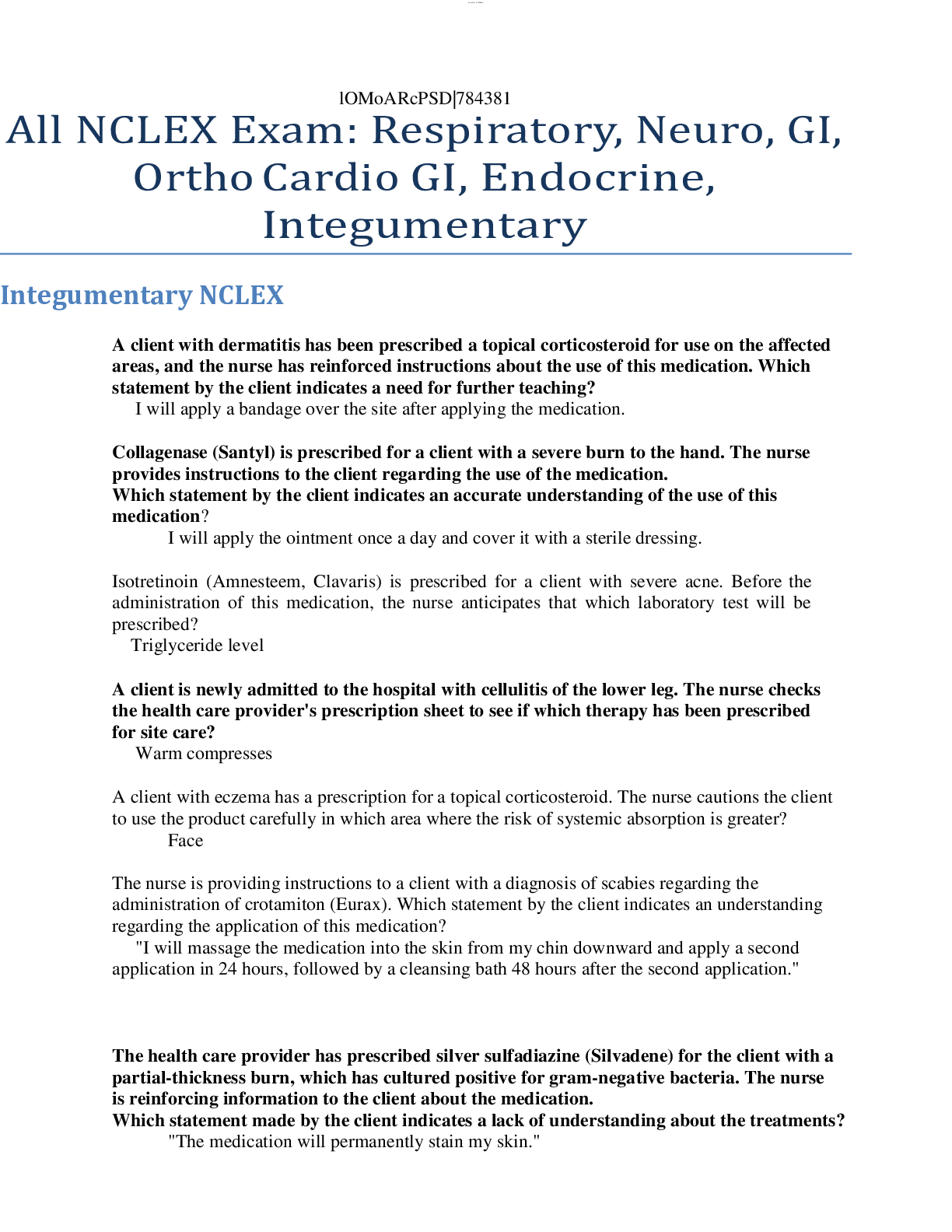
Reviews( 0 )
Document information
Connected school, study & course
About the document
Uploaded On
Jun 18, 2020
Number of pages
191
Written in
Additional information
This document has been written for:
Uploaded
Jun 18, 2020
Downloads
11
Views
607


